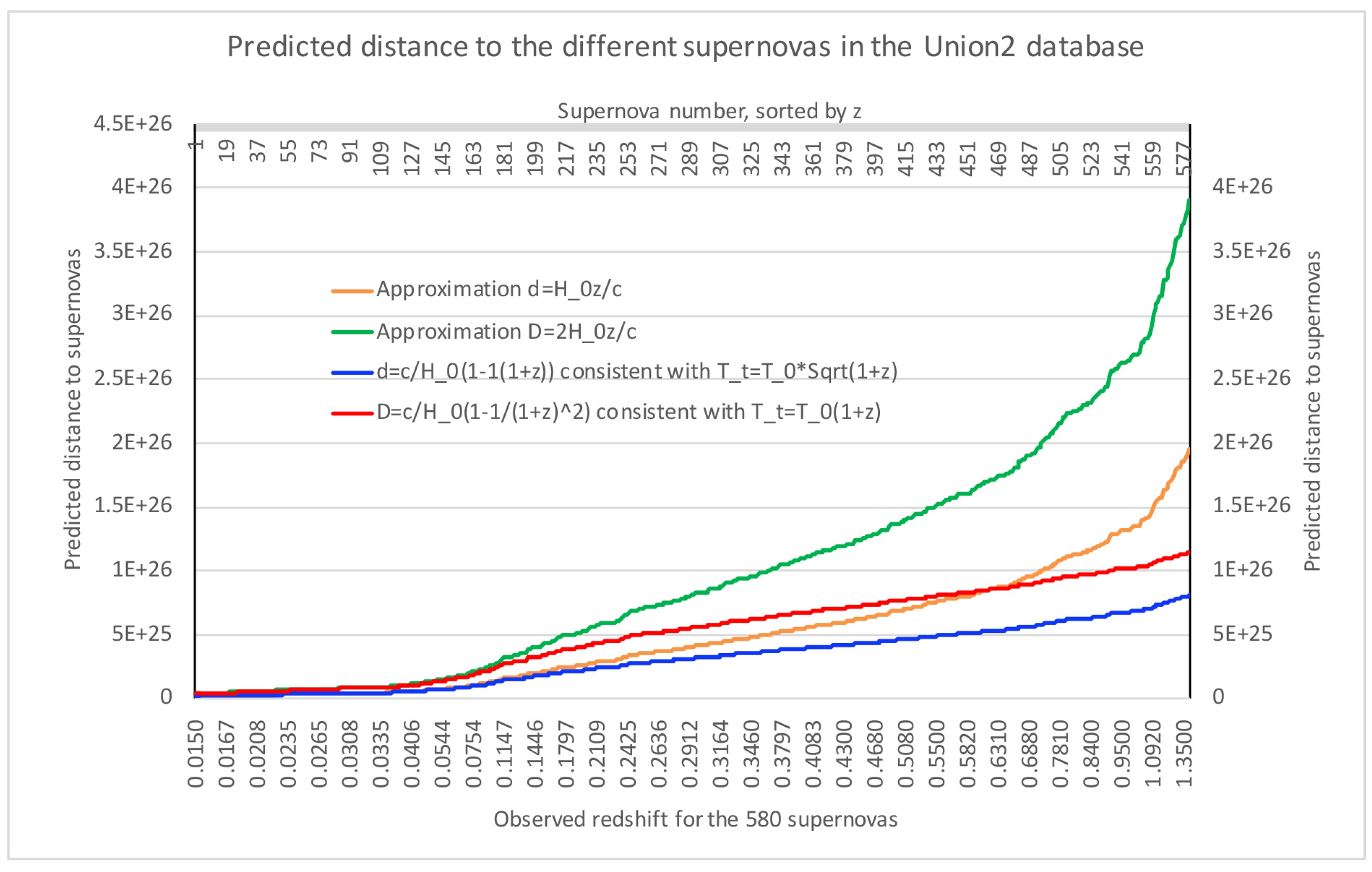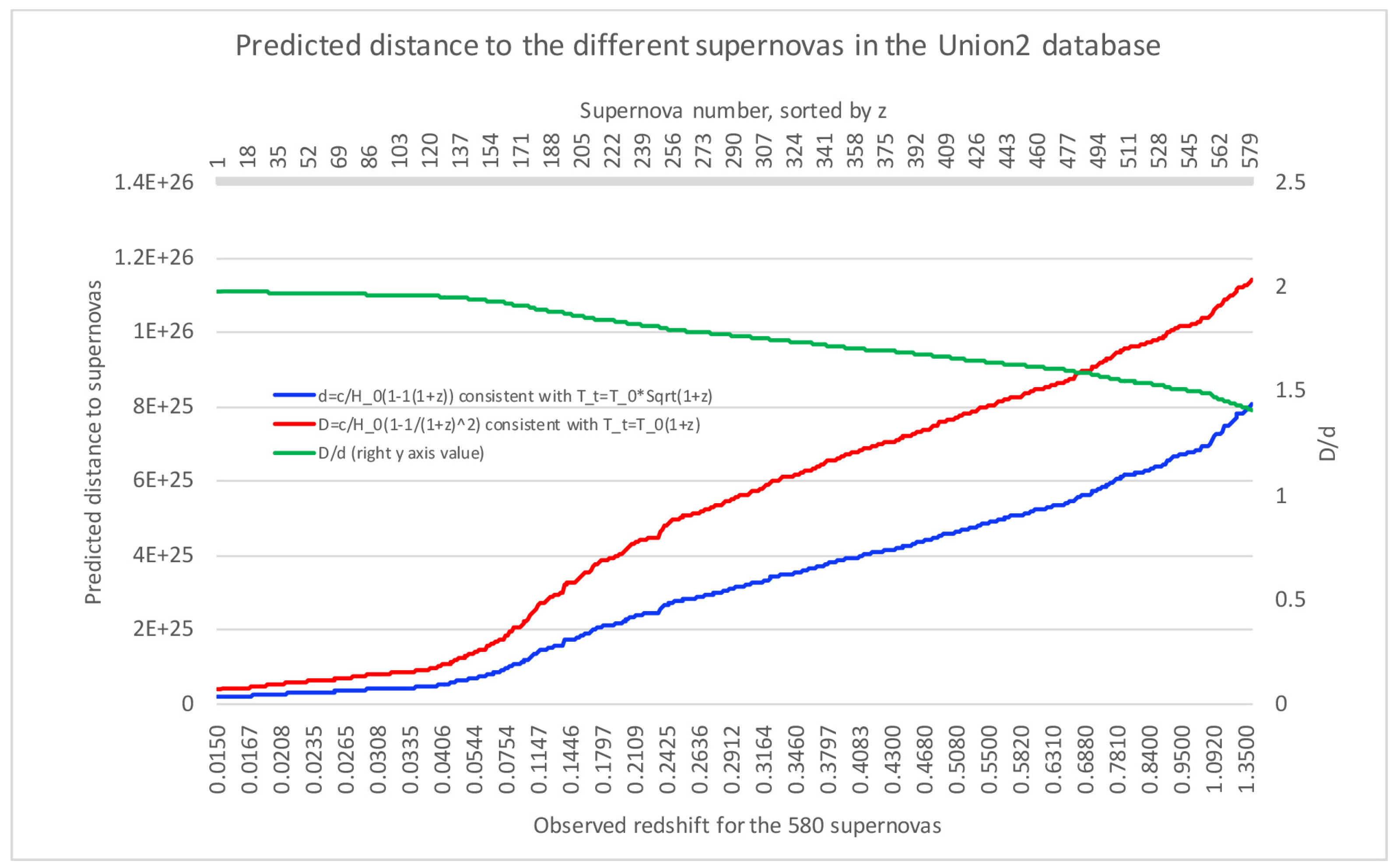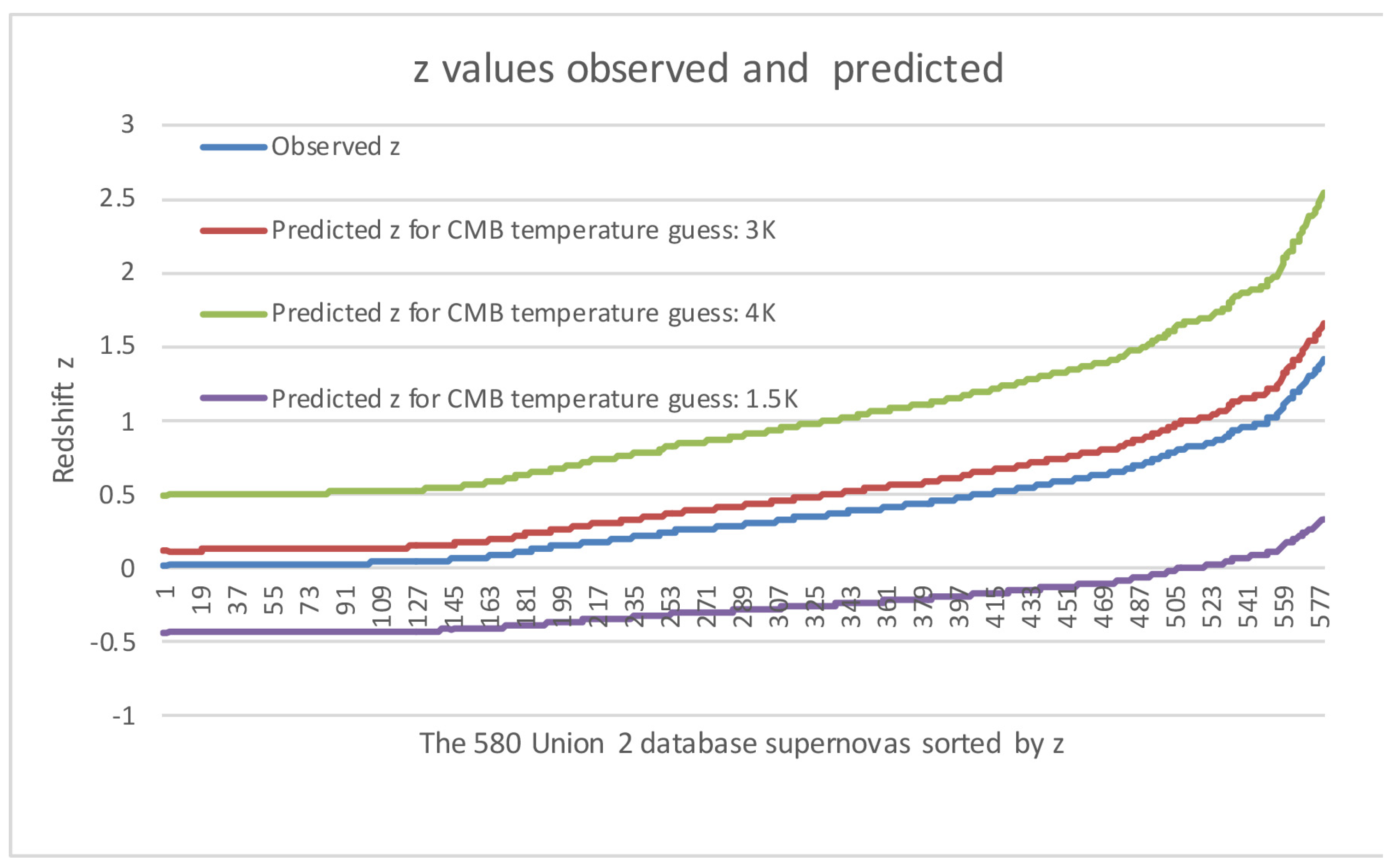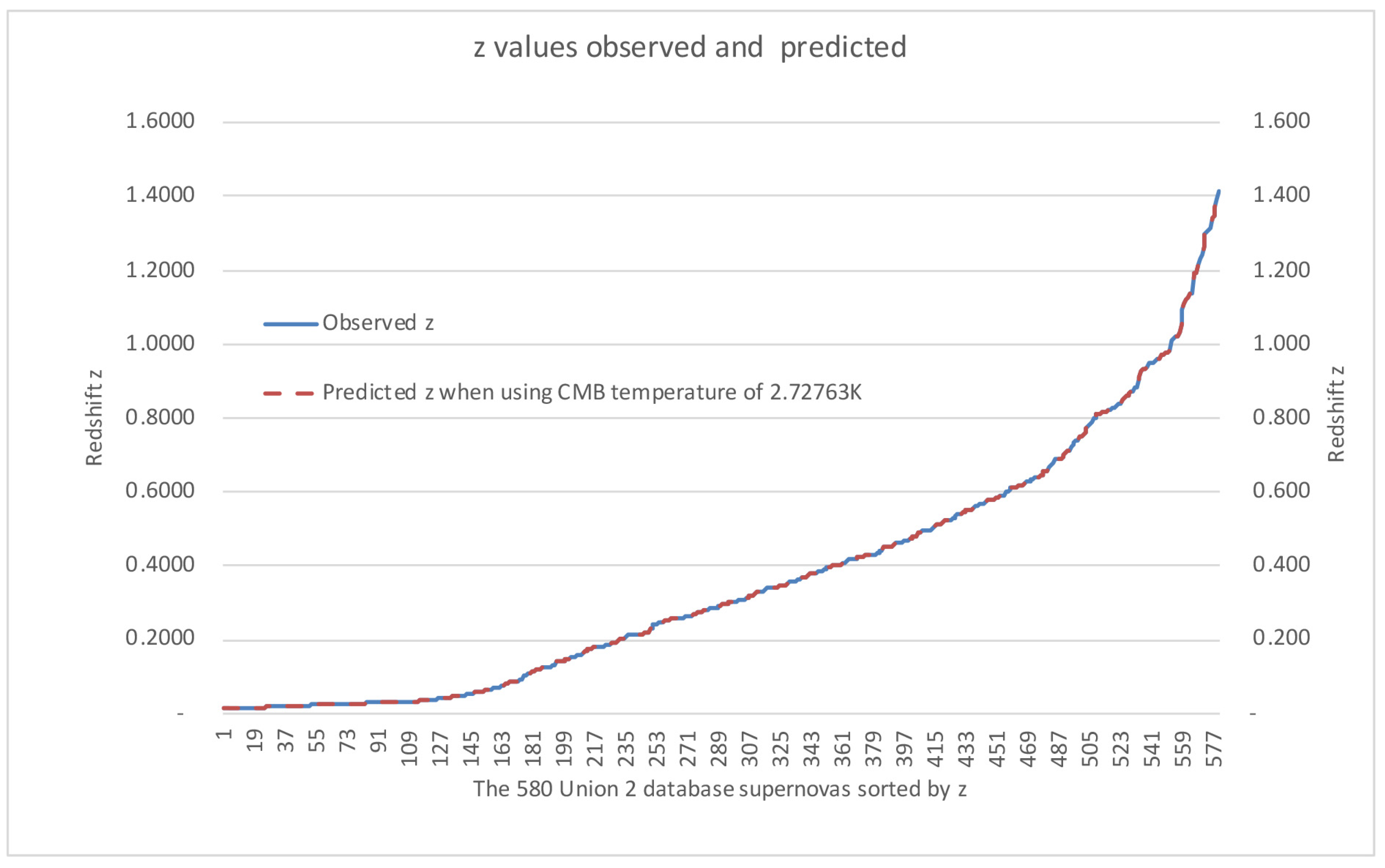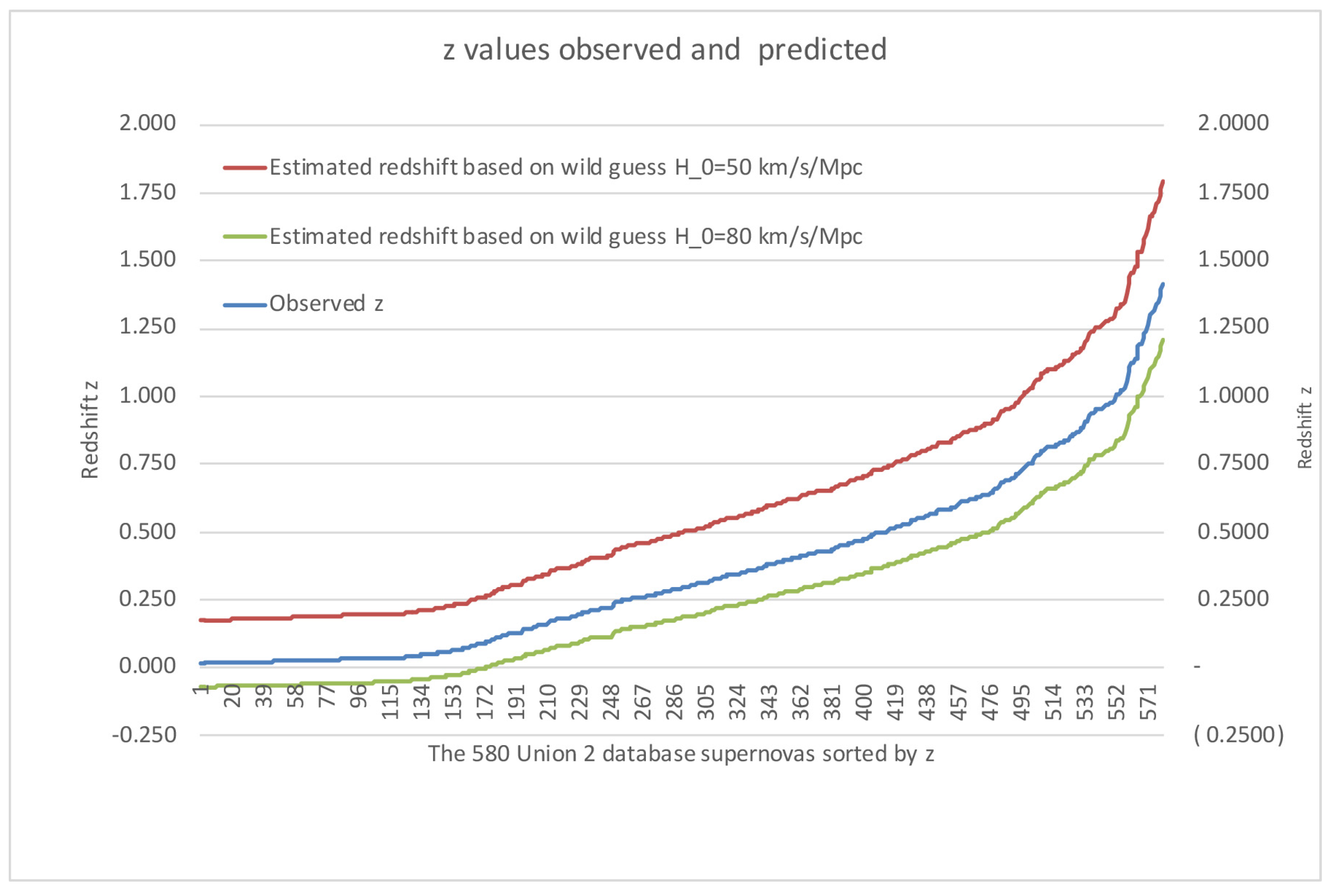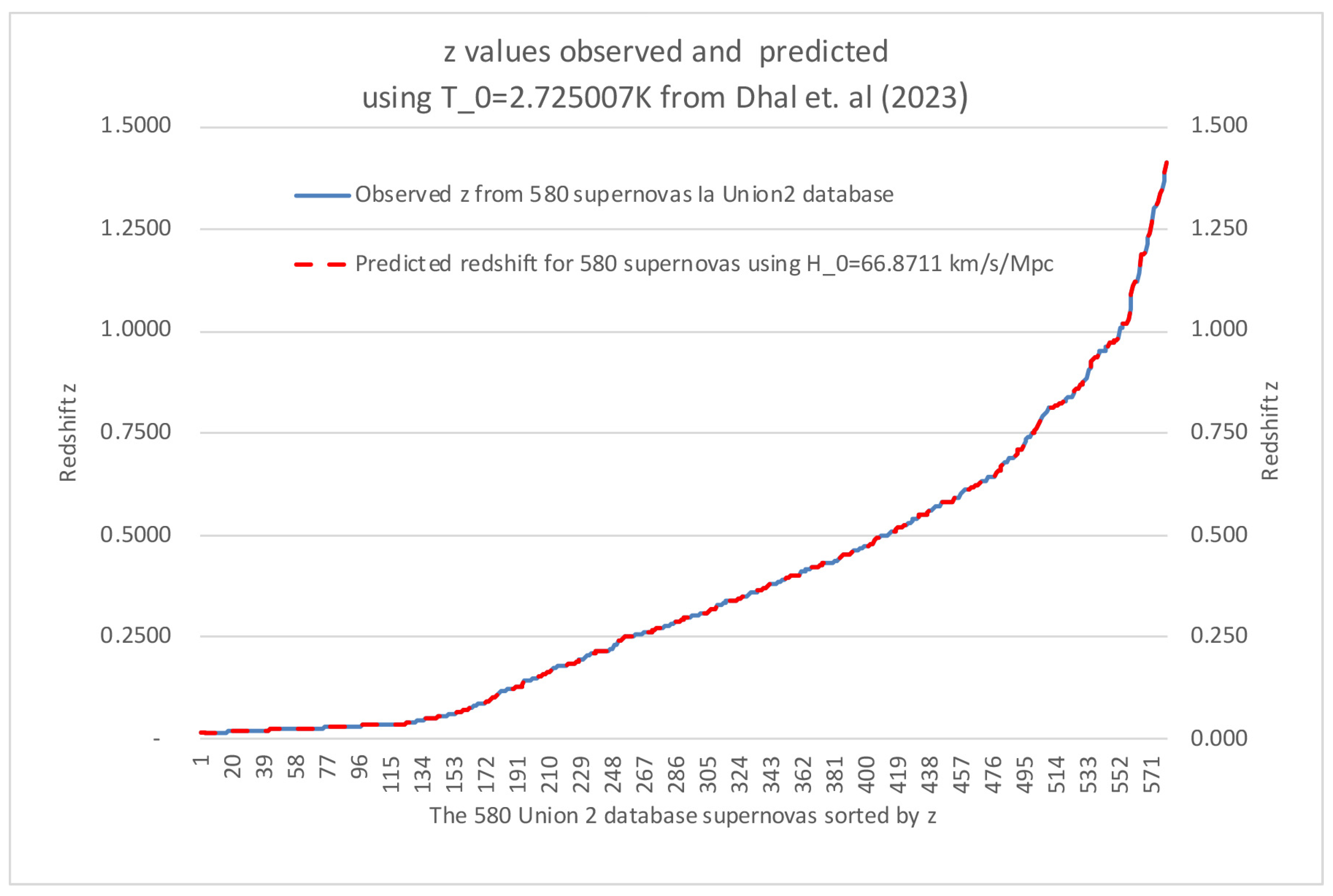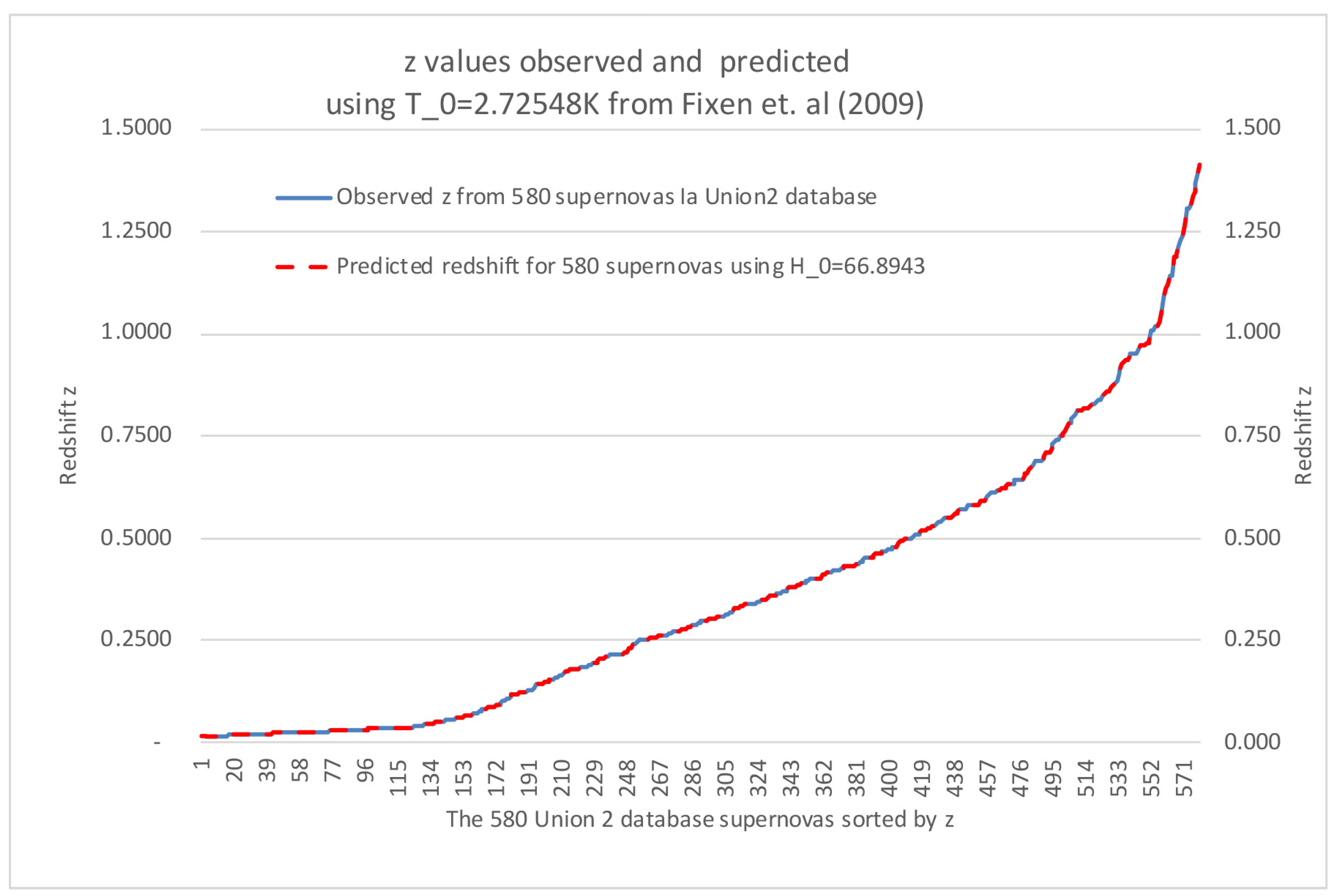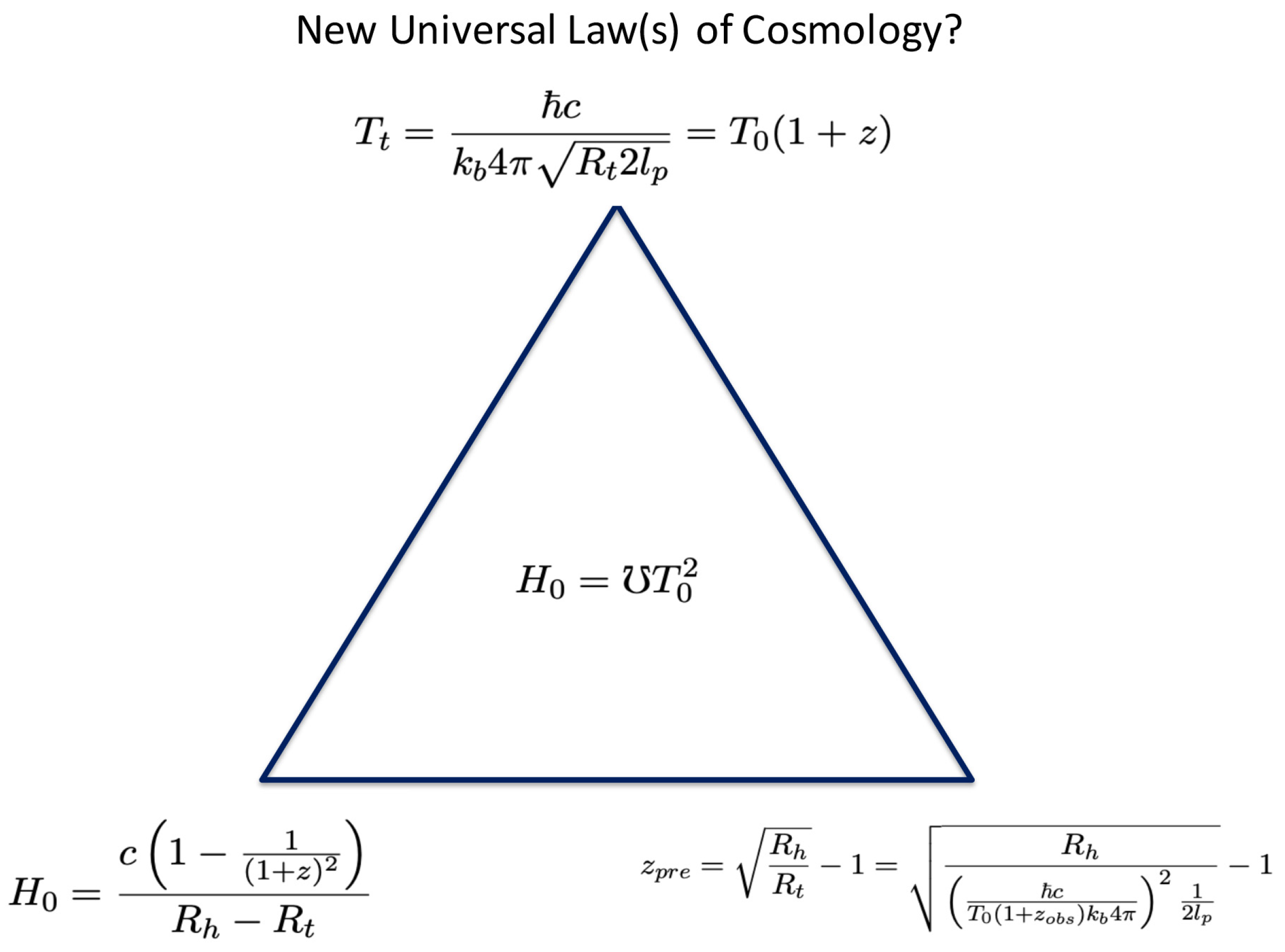1. The CMB Temperature Prediction Formula
Tatum et al [
3] presented the following formula for the Cosmic Microwave Background (CMB) temperature in 2015:
We can calculate this CMB temperature when using the current Hubble constant value given by Kelly and et. al [
4] of
. Symbols
and
are respectively the Planck mass and the Planck length (see [
5,
6]),
is the Boltzmann constant,
ℏ is the reduced Planck constant and
G is Newton’s gravitational constant.
and
represent the current Hubble mass and current Hubble radius, respectively. The current value
one can get by using the current CMB-determined Hubble constant
, and the current mass inside the Hubble sphere of the model we will describe as the Friedmann critical mass
; see [
3] for more in-depth discussion. This formula is quite similar to the Hawking black hole temperature formula [
7,
8]:
, except that one replaces
M with
. Despite its likely great potential significance, this formula has received little attention from the wider astrophysics community. The likely reasons are that it has not been published in one of the more prestigious established journals, and secondly, until recently, there have been no papers providing strong mathematical or other proofs of its foundation.
However, recently, Haug and Wojnow [
9,
10] have shown that formula (1) can be derived from the Stefan-Boltzmann law [
11,
12]. Furthermore, Haug and Tatum [
13] have derived the same formula from a geometric-mathematical approach, demonstrating its consistency with a geometric mean temperature between the lowest and highest possible current temperatures in the Hubble sphere. All of these approaches seem to create a consistent and interesting framework, particularly in line with growing black hole models such as the FSC Schwarzschild metric model, but likely also other growing black hole models that can be built around other metrics, such as [
14,
15,
16,
17].
An actively discussed class of cosmological models, in comparison to the
-CDM model, is the so-called
models. See, for example, [
18,
19,
20,
21,
22,
23,
24]. The FSC model, originating with the referenced Tatum et al 2015 paper, falls within the category of growing black hole variants of
models, which represent a subclass of
models. Thus, there is also thermodynamics related to the current and past CMB temperature in this cosmological model. A generalized version of formula (1) can be:
where
is the black hole radius at any stage in the growing black hole universe. In this model, the universe starts out with a Planck mass Schwarzschild radius of
and then expands one Planck length in radius per Planck time. Thus, one can also say that it increases by one-half a Planck mass per Planck time.
2. Cosmological Red-Shift from CMB Temperatures
In general, for many cosmological models, we have:
where
is the scale factor dependent on the cosmological model, and
is the reference time, which is now. In the
-CDM model, light is red-shifted based on the idea of the expansion of space and cosmic time. The redshifted wavelength can be treated as stretching as space-time expands. In
models, there is expansion of space and space-time corresponding to a constant horizon speed of light c. In such models, one can possibly also mathematically treat the redshift as a relativistic Doppler redshift in a pre-existing space, as outlined in reference [
3]. In the FSC Tatum et al model, we have
, which is simply the Hubble radius
at present. The Hubble radius is the distance light has traveled since the beginning of the black hole universe, which in the FSC model started as a Planck mass black hole and today is the Hubble sphere with mass equal to the mass in the critical [
25] universe
.
This means that, in certain
cosmological models, particularly the FSC growing black hole model, we can have:
where
and
. Alternatively, we could write this as:
In the current paper we provide some detail about its derivation and additional discussion. Tatum and Seshavatharam have been aware that the formula
is also likely valid, and have used it in a recent paper by [
26]. But then this has some potential implications, as discussed in the section below.
It is also worth looking at the
distance as a function of
z and
in the following way:
So, the distance to the observed redshift is then:
and solved for
we have:
where
is the estimated distance to the object emitting the photons.
When
we can use the first term of the Taylor series expansion which is:
and naturally:
where
is the distance to the object emitting the photon, that is identical to the standard
-CDM cosmological redshift prediction formula typically used for low
z values.
3. Comparison of versus
The
-CDM model has, for many years, been using the following redshift formula:
As there has been considerable uncertainty as to whether this really is the best model of CMB temperature versus cosmological red shift
z, Lima et al. [
27] suggested the following generalization of the formula:
where
is an unknown constant that, if set to zero, yields the standard formula
; however, it has also been suggested that
can be other than zero. Chluba [
28] has suggested that: “
decay of vacuum energy leads to ‘adiabatic’ photon production (or destruction), such that the CMB temperature scales like."
Research based on observations suggests that
should be close to zero. For example, see Riechers et al [
29]. However, this is still uncertain, as measuring CMB temperatures at high redshifts (
z) is subject to significant uncertainties. Additionally, measuring cosmological redshift can be challenging because there are no direct observations of the emitted photons; we can only observe the received photons. This means that cosmological redshift is always seen through the lens of a mathematical model, and it is never entirely free of assumptions. On the other hand, measuring phenomena such as Doppler redshift or gravitational redshift on Earth provides much better control because we can directly compare the wavelengths of the emitted and received photons with minimal reliance on model assumptions. We mention this because one can then easily imagine how much more difficult it must be to know the exact CMB temperature for a given cosmological redshift. Based on knowledge of `standardized’ objects as well as decades of impressive research in cosmology, one can make an educated guess; nevertheless, there could still remain some uncertainties.
If we set
then we can “only"
1 make
compatible with CMB equations (1) and (
2) in the following manner:
In that case would give the same result as in the previous sections, except we now also must have which is an alternative possibility that should be carefully investigated, as this potentially could have an impact on how one interprets space expansion in accordance with the -CDM and models.
Riechers et al [
29] have reported the Cosmic Microwave Background (CMB) temperature from the cosmic epoch at
, resulting in a temperature range of
within one standard deviation uncertainty. In other words, even the one standard deviation, which represents only about 68% probability for the CMB temperature to be inside that range, is very wide. The two standard deviation CMB temperature range is much broader. Therefore, we can conclude that the formula
is not sufficiently well-tested, given the very large uncertainty. The formula
predicts a CMB temperature of
which is well inside the 95% confidence interval of the above report (using two standard deviations); however, as we have also shown, the FSC framework at present also appears to be consistent with
. Only further investigation can help us to decide on the optimal choice, even if observations appear to currently favor
.
It is also worth looking at the
distance as a function of
z and
in the following way:
So, the distance to the observed redshift is then
and naturally:
where
, which is the distance between us and the object emitting the observed photons. When
we can use the first term of the first order Taylor series expansion and we get
that naturally gives:
and naturally
This is indeed different from the standard redshift formulation. However, in this case, the distance
D will also differ from the distance predicted by the standard formula. Therefore, only careful further investigation can determine whether it is superior to the standard formula
or not. First of all, it is important to be aware that we have:
These two formulas give identical predictions for and z when dealing with short distances and low z. The ’2’ in the numerator is offset exactly by the fact that in the denominator. This holds true when the distance is short (). Thus, when used to extract the Hubble constant from, for example, nearby supernovae, the estimated or estimated z are identical. It is the distances that differ in the two approaches. However, when dealing with supernovae or other objects far from us, the estimated Hubble constant values will be different, as we then need to use the exact formulas, rather than convenient approximations. This implies that in the standard -CDM model, the value of the Hubble constant based on redshifts far away is likely overestimated.
For redshift and Hubble constant analysis at short distances, we can say that the -CDM model likely has two errors that cancel each other out: it has the wrong distance and also the wrong formula, which offsets the error in the wrong distance. Therefore, its predictions for redshift z and at short distances will be correct and the same as in our model. However, at much larger distances, their model will not be fully accurate, which we believe has led to the Hubble tension problem. This issue is addressed with our new way of looking at redshifts, as will become clear from the remainder of our paper, particularly in the sections where we aim to resolve the Hubble tension, namely sections 4 and 5.
If this latter redshift formula is correct, then distances to astronomical objects based on redshift are likely off by as much as a factor of 2. This could explain why the -CDM model must have an expansion of space faster than models. Once again, we believe that our new approach and explanation likely resolves the Hubble tension problem.
If one is not deeply entrenched in the topic, it may be easy to assume that our redshift Equation (
20) must be incorrect, given the highly precise measurements of distances to various astronomical objects through independent methods, such as parallax. However, supernova distances are never measured directly by a method as elementary as parallax. Establishing their distances requires a complex understanding of the astronomical distance ladder and the inherent uncertainties built into each rung of this ladder. Type Ia supernovae represent some of our most reliable standardized candles. Therefore, the most accurate method of determining their distance is likely through cosmological redshift, albeit this approach is naturally model-dependent. While our math, which suggests that the distance to the more remote supernovae is approximately twice that predicted by the
-CDM model, may initially seem unfeasible, based on our current limited knowledge, it should not be immediately discounted. We would welcome any compelling arguments against our findings, in particular after studying the rest of our paper.
Figure 1 shows the predicted distances for 580 supernovae from the Union2 database. We have sorted the supernova database based on redshift, so that supernova number one has the lowest redshift and supernova number 580 has the highest. Then we have predicted the distances based on the two approximation formulas. The two approximation formulas are based on the first term of the Taylor series expansion and are, in reality, only good approximations when
. This is why these approximations strongly overestimate the distances for high-
z supernovae. The two exact solutions, based on the assumptions given in this paper, yield different values. The one consistent with
predicts that the more remote supernovae are about twice as far away from us as the
-CDM model predicts. The one consistent with
gives the same distance predictions as the standard model, at least for
, but then the relationship between the current CMB temperature and that in past cosmic epochs is different for the
-CDM model. We need the current value of
to make the distance approximations, which we take from the very recent study of Sneppen et al [
30],
.
In
Figure 2 we have removed the approximation models and we now focus on those models which are relatively more accurate at higher redshifts. This makes more obvious the difference between the model consistent with
and the model consistent with
. Be aware that the
-CDM model predicts the same distances as the blue line, at least for low
z values. The red line prediction is what likely is correct, however, as it is consistent with
, which we will show that observations seem to favor. This will become more clear in the next section. The green line represents
. We can see that, for low
z quasars, the standard model is off by a factor of almost 2, which also appears to be true for the higher observed
z supernovae in the Union2 database. There is more explanation to follow.
4. Extracting the Current CMB Temperature from 580 Type Ia Supernovae
Here we use the observed redshifts from 580 supernova data points in the Union2 database to determine the current CMB temperature (). The methodology employed is as follows: from the cosmological redshifts, we first predict the CMB temperatures for each observed z value, by using the standard and well-known relation . Since our goal is to find a priori, we start with a wild guess. For instance, we might start with , or even , which is naturally far off from the currently observed CMB temperature of approximately . We start with a wild guess because we will later use optimization to determine if there exists a that leads to an estimation error near zero, using the redshift prediction formula . This can be achieved using optimization algorithms such as the Newton-Raphson method or the bisection method.
Next, we calculate the radius of the Hubble sphere going back in time for each
z value. This is done by assuming a FSC-like
cosmology and solving Equation (
2) for
. This gives:
and since we also have
we can replace
with this and get:
Because we are assuming that we do not know
, we will not rely upon measured CMB temperatures. However, we can now input this expression for
into our redshift formula (Equation
15) and we get:
We can now minimize the errors between
and
by adjusting the unknown
value. This can be accomplished through pure trial-and-error, or more efficiently by using “intelligent" trial-and-error systems such as the Newton-Raphson method or the bisection method. The results from these approaches are the same, except that, by naive trial-and-error, one will waste more time finding the optimal CMB temperature. To do this, we also need
, which is the current Hubble radius, and therefore, we also need the current value of
, which we take from the very recent study of Sneppen et al [
30],
. Thus,
affects the value; it is actually this relatively new theoretical relationship between
and CMB, first implied by Tatum et al [
3] in 2015 and later proved to be derivable from the Stefan-Boltzmann law by Haug and Wojnow [
9,
10], that makes this method possible. We also need the Planck length in our formula, so we have used the NIST CODATA (2018) value of
m (with standard uncertainty of
). This uncertainty is therefore reflected in the reported STD for both our predicted CMB temperature as well as our predicted
using the Union-2 database.
Figure 3best illustrates the trial-and-error procedure. Assume that we initially have guessed a CMB temperature of
. This is the green line in the figure, that we see is far above the observed redshift represented by the blue line. However, at least it looks like it correlates well. Still, the
prediction is way off. Given that the redshift predictions are proportional to the current CMB temperature, we must guess a lower CMB temperature. Assume that we now guess
; we then get the predictions presented by the purple line. It becomes obvious that our
prediction is now too low compared to the observed redshifts. We now know that the CMB temperature needed in order to minimize the prediction errors must be between
and
. We, therefore, now guess
, and the redshift predictions we get from this are much closer to observed, but still too high.
We can continue ‘manually’ like this, or we can resort to efficient search algorithms that are used for similar statistical problems in many scientific fields. Among the most commonly used algorithms are the Newton-Raphson method or the bisection method. One can also use the goal seek function in Excel, which is likely based on the bisection method. These trial-and-error methods are simply a form of calibration method. The question is whether there exists a single CMB temperature, denoted as , for the current epoch of the cosmos that can make our “CMB redshift prediction formula” match the observed redshifts with precision.
Effectively, we are calibrating our new cosmological redshift prediction equation relative to the observed 580 supernova redshifts by finding what value of minimizes our prediction error. Only one parameter is adjusted (optimized), namely the “unknown” current CMB temperature, so that the errors indicated by the sum of are minimized. This approach results in a predicted current CMB temperature from the 580 supernova observations in the Union2 database. We are not claiming that the current CMB temperature is exactly this (although it could be); rather, this is what it appears to be, based on the observed supernova redshifts in combination with the . When we also take into account the uncertainty in the value of (), as reported in the study of Sneppen et. al, we get a one standard deviation (STD) confidence interval range of to for the current CMB temperature. The reason we provide the numerous digits in is simply to enable others to obtain the same value when utilizing following the procedure outlined in this paper. This is not meant to imply that we can determine the CMB temperature with such high precision. The measured CMB temperature has a lower uncertainty compared to our predicted CMB temperature. Rather, what is important to understand here is that we have a model that directly links the current CMB temperature to the Hubble constant and redshift. To the best of our knowledge, the -CDM model does not offer such a direct relationship between the current CMB temperature and .
As different Hubble constant measurement studies and methods yield considerable uncertainty in
, this uncertainty could be even larger. Moreover, there is the unexplained Hubble tension problem; see for example [
31,
32,
33,
34]. Nevertheless, using our new radically-different theoretical approach, we can closely approximate the recent CMB temperature observations by [
1,
2,
35,
36].
By using a current CMB temperature
, the predictions from Equation (
26) are now perfectly aligned with the observational blue line in
Figure 1. In other words, the redshift formula we have presented is now capable of matching observed cosmological redshifts. See
Figure 4.
It is interesting that, by incorporating only the current CMB temperature, our redshift prediction function can match observations. It is important to note that we are using the same epochal for all supernovae, rather than different values for different supernovae. This basically demonstrates that our framework is consistent and robust. Our findings are fully consistent with the empirically-tested relation and also with the FSC growing black hole variant of cosmology. It is our recommendation that the astrophysics community pay attention to this result and investigate to what degree it is or is not consistent with the -CDM model. Could it be that the -CDM model needs further adjustments? Or could it be that models are actually more realistic in some respects? Only further research can settle these questions. In either case, researchers should be made aware of the recent progress in our theoretical understanding of CMB temperature and its relationship to cosmological redshift and the Hubble constant.
5. Why We Think That We May Have Solved the Hubble Tension Problem
In the section above, where we found the CMB temperature that optimally fits with the observed supernova redshifts, we had to know the Planck-derived Hubble constant value. Alternatively, one can use the observed CMB temperature to optimally fit a Hubble constant value for the same 580 supernova redshifts. The CMB temperature has been extremely accurately measured in recent years, for example, by [
1,
2,
35,
36].
First we will use the most recent measurement by Dhal et al [
1] of
. We then start out by assuming that we know very little about the Hubble constant value. All we know is that many different studies have arrived at different values. So we start with a qualified, but wild, guess that it must be in a range from 50 to
. We then ask if there is a single Hubble constant
value that, when used in our new CMB redshift prediction formula, matches all of the observed supernova redshifts. So, we start with a guess of
and use the same formula as in the previous section:
The only difference in our approach (compared to in the previous section) is that we now substitute the measured CMB temperature by Dhal et al for
. In the previous example, we assumed that we knew
and tried to find
. We can now use
to solve for
. The result is shown in
Figure 5 as the red line. Once again, the actual observed redshifts for all 580 supernovae in the Union2 database are represented as the blue line. As we can see, the red line indicates that this was an underestimated Hubble constant value, as our redshift prediction formula is inversely related to
. Accordingly, we next guess a much higher Hubble constant value, for example
, which gives redshift predictions correlating to the green line. Now the redshift predictions are too low. By simple trial-and-error, or by "intelligent" trial-and-error methods, such as the Newton-Raphson method or the bisection method, we can find the
that minimizes the errors between predicted and observed redshifts.
Figure 6 shows the end-result. We obtain
(corresponding to a 1STD range of
to
) extracted from all of the supernovae when linked to the Dhal et al current CMB temperature. A similar approach is used for the Fixen et al (2009) [
2] CMB temperature of
. See
Figure 7, which is best fitted with
(corresponding to a 1STD range of
to
).
Here, it is important to be aware that we are able to achieve essentially a perfect fit with all of the Union2 database supernovae using either a single Hubble constant value or a single CMB temperature. This appears to us to solve the Hubble tension problem in favor of the Planck Collaboration Hubble constant determination. The Hubble constant value cannot be measured directly; it is the redshift that is measured in the type Ia supernova studies. The Hubble constant is estimated, and therefore relies on a model-based definition of redshift. In this paper, we use a new redshift model rooted in our new understanding of the inter-relationships between the current CMB temperature, the current Hubble constant, and cosmological redshifts; see [
3,
9,
37]. This approach is clearly consistent with black hole variants of
cosmological models. Whether it can also be made compatible with the
-CDM model is too early to say. If so, we believe that the
-CDM model, at minimum, would need some adjustments. Alternatively, it may be that such
model variants are actually more realistic.
Our results are also fully in line with the recent findings of Tatum et al [
38] that one can accurately find
from knowing the current CMB temperature, something that the
-CDM model cannot do at present, as far as we know. Herein, we have taken an additional step forward and linked these two cosmological parameters to cosmological redshift. These inter-relationships are consistent with core principles in such
cosmology model variants in general, and FSC in particular.
7. Conclusion
In the context of growing black hole
model variants, we now have a robust theoretical framework for predicting the Cosmic Microwave Background (CMB) temperature, using a known Hubble constant value [
10], or vice versa [
3]. This can be done both for present and past cosmic epochs (presumably), as well as in relation to cosmological redshifts. This framework initially emerged from the FSC cosmological model proposed by Tatum et al. However, it is worth exploring whether it can also be applied to other black hole
models. The theory appears to be compatible with the relationship
, but only when
or
. Although it appears that we are gaining a new perspective on understanding and investigating cosmological redshift, further theoretical and observational studies are needed in order to reach a final consensus. There is still much to be discovered.
In this paper, we have demonstrated, from the observed redshifts of 580 type Ia supernovae (the Union2 database), how one can predict a CMB temperature of . Furthermore, we predict that future type Ia supernovae will show a similar excellent fit with a current CMB temperature of . Given its derivation, our CMB redshift prediction formula is, of course, also fully consistent with the formula, so long as is zero.
We have also demonstrated how to achieve a perfect match between particular Hubble constant values and observed supernova redshifts, simply by incorporating the observed CMB temperatures from two well-known CMB studies. We refined our predictions by minimizing errors in our redshift prediction formula relative to the observed redshifts from the same 580 type Ia supernovae. Utilizing the CMB temperature from Dhal et. al (2023) of
, we derive a Hubble constant value from the full supernova database of
. Similarly, utilizing the CMB temperature from Fixen et al. (2009) of
, we obtain a Hubble constant value from the full supernova database of
. Remarkably, our redshift formula can accurately predict the redshift of every supernova in the Union2 supernova database after calibration for distance. While this process resembles curve-fitting, the only free parameters are either the Hubble constant or the CMB temperature, with one being derived from measurement and the other automatically determined as a result. These results are consistent with the predictive power mentioned in references [
37,
38]. Accordingly, we believe that our new approach has likely resolved the Hubble tension problem in favor of the Planck-based CMB-derived Hubble constant value. Nevertheless, our work should undergo careful scrutiny by others before drawing any firm conclusions.
